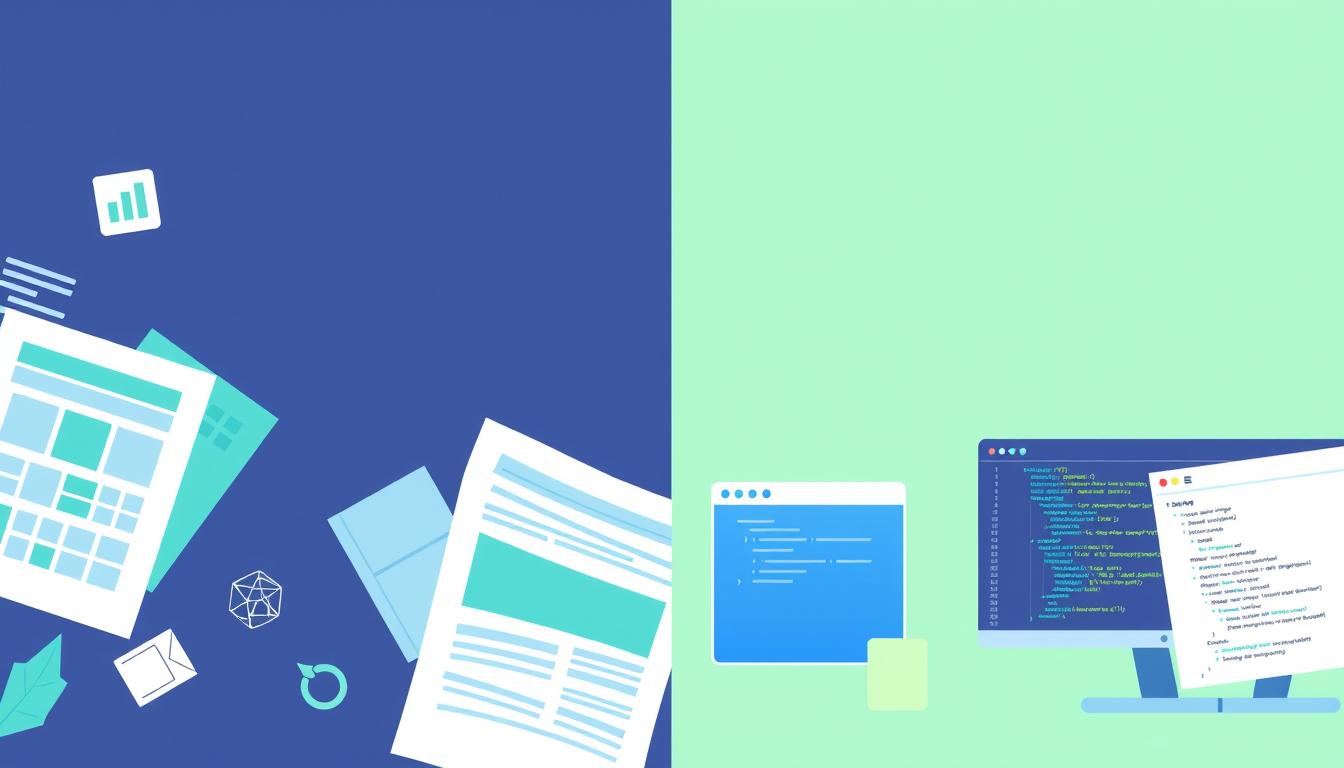In today’s digital landscape, the approach to web design and development can make or break your online presence. Traditional methodologies often create disconnects between design and functionality, leading to extended timelines and budget overruns. At Defyn, we’ve reimagined this process with an integrated approach that bridges these gaps, delivering websites that not only look stunning but perform exceptionally well.
This article explores how our unique methodology differs from conventional approaches and why it matters for your business’s digital success. Whether you’re planning a new website or considering a redesign, understanding these fundamental differences will help you make informed decisions about your digital journey.
Understanding Web Design and Development Fundamentals
The interconnected nature of web design and development
Before diving into methodologies, let’s clarify what web design and development actually entail. While often mentioned together, they represent distinct disciplines with different focuses and skill sets.
Web Design: The Visual and User Experience
Web design encompasses the visual elements and user experience of a website. Designers focus on creating intuitive interfaces that guide users through content while maintaining brand consistency. This includes:
- User interface (UI) design – creating visually appealing layouts
- User experience (UX) design – ensuring intuitive navigation and interaction
- Visual elements – typography, color schemes, imagery, and spacing
- Wireframing and prototyping – planning the structure and flow
- Responsive design – ensuring the site works across all devices
Web Development: Bringing Designs to Life
Web development involves writing code to implement the design and create functionality. Developers build the technical foundation that powers the website, including:
- Front-end development – implementing visual elements with HTML, CSS, and JavaScript
- Back-end development – creating server-side logic, databases, and APIs
- Performance optimization – ensuring fast loading times and smooth operation
- Security implementation – protecting user data and website integrity
- Integration with third-party services – connecting with payment gateways, CRMs, etc.
The challenge for many businesses lies in how these two disciplines interact. Traditional approaches often treat them as separate phases, which can lead to disconnects and inefficiencies. This is where methodology makes all the difference.
Traditional Web Design and Development Approaches
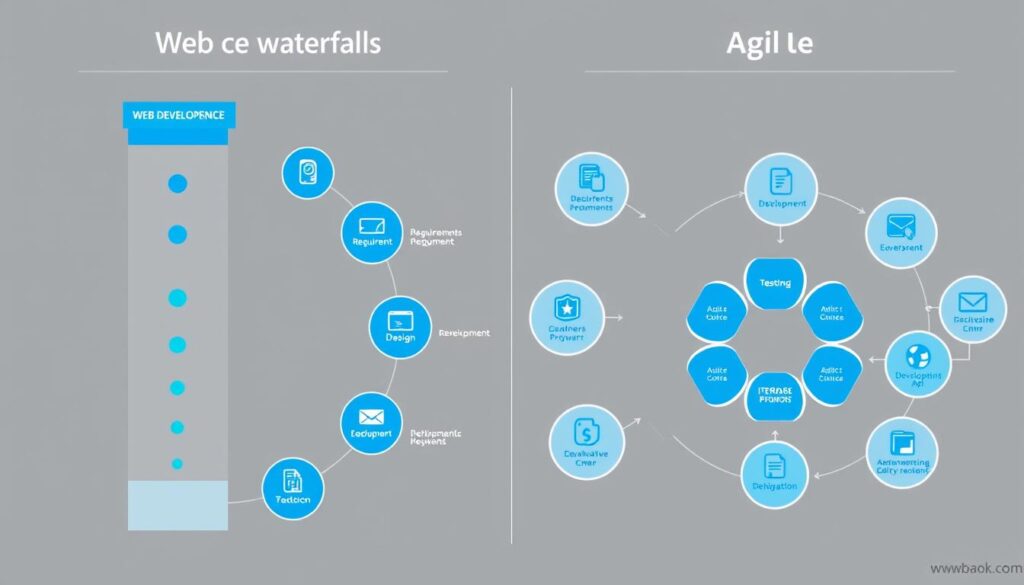
Most web agencies follow one of two primary methodologies: Waterfall or Agile. Each has distinct characteristics that influence project timelines, collaboration, and outcomes.
The Waterfall Methodology
The Waterfall approach is a linear, sequential process where each phase must be completed before the next begins. It follows a strict progression:
- Requirements gathering and documentation
- Design phase (wireframes, mockups, approvals)
- Development phase (coding and implementation)
- Testing phase (quality assurance)
- Deployment and maintenance
Waterfall Advantages
- Clear structure and documentation
- Predictable timeline and budget
- Well-defined deliverables at each stage
- Easier to manage with less experienced teams
Waterfall Disadvantages
- Inflexible to changes once development begins
- Client doesn’t see progress until late stages
- Design-development handoff often creates issues
- Higher risk of project failure if requirements change
The Agile Methodology
Agile takes an iterative approach, breaking projects into smaller cycles called “sprints.” Each sprint delivers a working piece of the website, allowing for continuous feedback and adaptation.
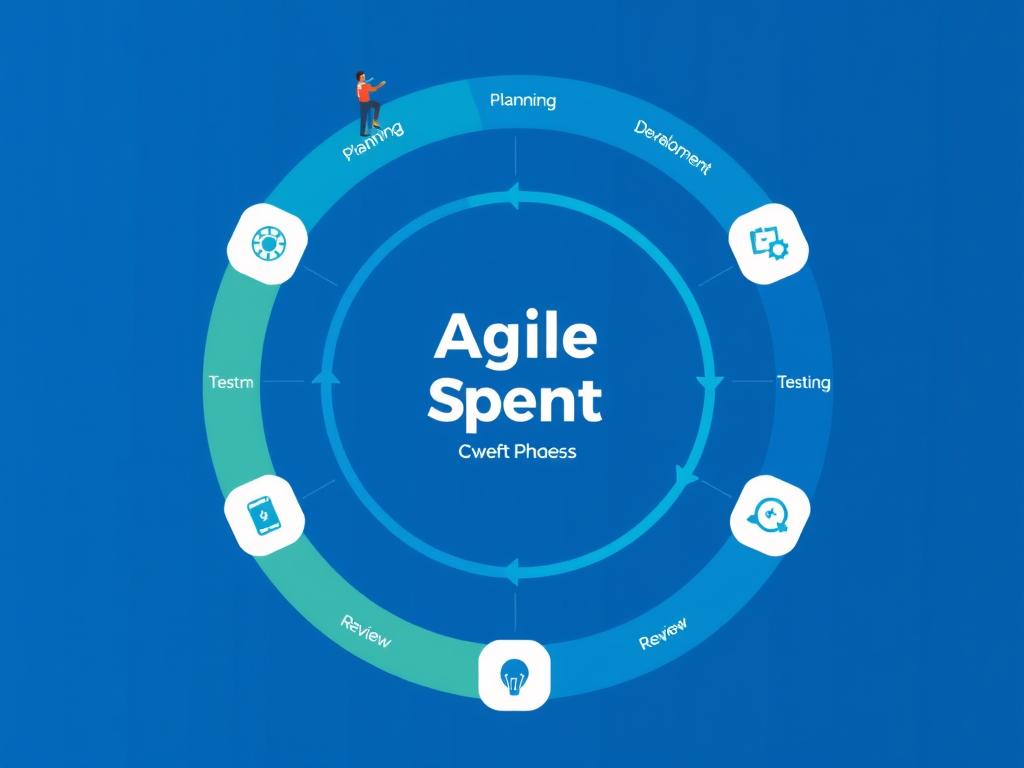
Agile Advantages
- Adaptable to changing requirements
- Regular client feedback throughout the process
- Earlier detection of issues and problems
- Continuous improvement of the product
Agile Disadvantages
- Less predictable timeline and budget
- Requires more client involvement
- Documentation may be less comprehensive
- Can lead to scope creep without proper management
Common Tools in Traditional Approaches
Design Tools
- Figma – collaborative interface design tool
- Adobe XD – UI/UX design and prototyping
- Sketch – digital design for Mac users
- InVision – prototyping and collaboration
Development Tools
- Front-end: React, Angular, Vue.js
- Back-end: Node.js, Python, PHP
- CMS: WordPress, Drupal, Shopify
- Version control: Git, GitHub
Struggling with your current web development process?
Our team can help you identify bottlenecks and suggest improvements to your current workflow, even if you’re not ready for a full project yet.
The Defyn Approach to Web Design and Development

At Defyn, we’ve developed a hybrid methodology that takes the best elements of traditional approaches while eliminating their weaknesses. Our process is built around three core principles: integration, iteration, and client partnership.
Integrated Design-Development Collaboration
Unlike traditional models where designers hand off completed work to developers, our designers and developers collaborate from day one. This integration offers several advantages:
- Technical feasibility is assessed during the design phase, not after
- Developers provide input on performance implications of design choices
- Designers understand technical constraints before finalizing concepts
- Shared ownership leads to better solutions and fewer revisions
“The magic happens when designers understand development constraints and developers appreciate design principles. At Defyn, we’ve created a culture where these disciplines don’t just coexist—they enhance each other.”
Iterative Prototyping and Validation
We believe in showing, not just telling. Our process includes early, functional prototypes that allow clients to experience their website before full development:
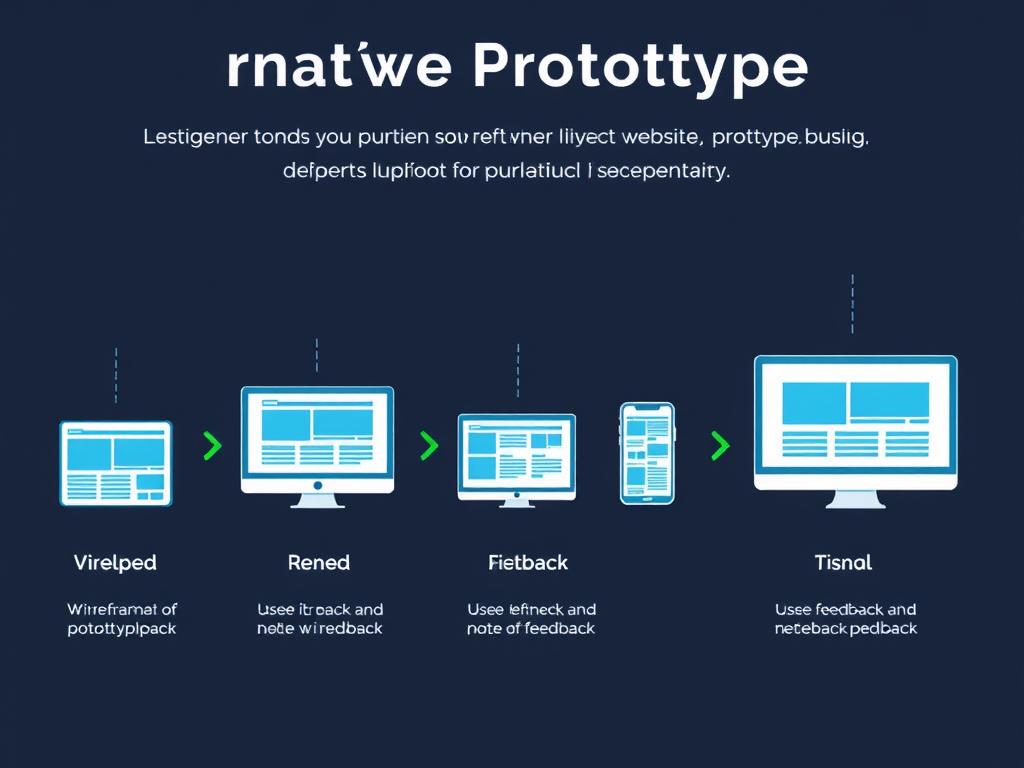
- Interactive wireframes – test navigation and information architecture
- Design prototypes – validate visual direction and user experience
- Functional prototypes – test core functionality with real data
- Continuous refinement – incorporate feedback at each stage
Client-Centric Partnership Model
We view our clients as partners in the creation process, not just approvers. This partnership includes:
- Transparent communication through dedicated project portals
- Regular strategy sessions to align on goals and priorities
- Education on the “why” behind recommendations
- Flexible involvement levels based on client preference
Defyn’s Technology Stack
Our approach is supported by a carefully selected technology stack that balances innovation with reliability:
| Category | Primary Technologies | Benefits |
| Front-End | React, Next.js, TypeScript | Performance, maintainability, future-proofing |
| Back-End | Node.js, Python, GraphQL | Scalability, security, efficient data handling |
| CMS | Headless CMS (Contentful, Sanity) | Content flexibility, omnichannel delivery |
| Design Tools | Figma, Storybook | Collaboration, component-based design |
| DevOps | CI/CD, Docker, AWS/Azure | Reliability, security, scalability |
Ready to experience the Defyn difference?
Let’s discuss how our integrated approach can deliver better results for your next web project.
Key Differences: Traditional vs. Defyn Approach
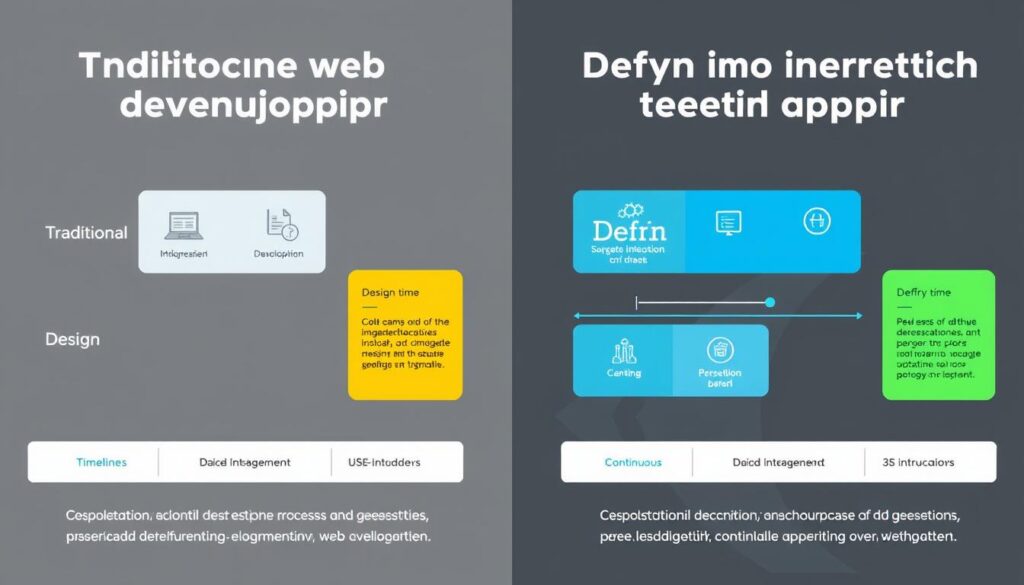
To help you understand how Defyn’s approach differs from traditional methodologies, we’ve created this comparison of key factors that impact project success.
| Factor | Traditional Approach | Defyn Approach | Client Benefit |
| Timeline | 3-6 months for medium projects | 30-50% faster delivery | Quicker time to market and ROI |
| Revision Cycles | Major revisions after development | Continuous small adjustments | Lower costs, fewer surprises |
| Client Involvement | Primarily at handoff points | Regular but focused touchpoints | Greater control without overwhelming time commitment |
| Technical Debt | Often accumulates during rushed development | Minimized through continuous refinement | Lower long-term maintenance costs |
| Adaptability | Changes are costly after design phase | Flexible to evolving requirements | Product better aligned with actual needs |
| Knowledge Transfer | Limited to documentation handoff | Ongoing education throughout process | Better understanding and ownership of final product |
Cost Efficiency Comparison
While our integrated approach may have similar upfront costs to traditional methods, the total cost of ownership is typically lower due to:
Short-Term Savings
- Fewer revision cycles
- Reduced development rework
- More accurate initial estimates
- Faster time to market
Long-Term Value
- Lower maintenance requirements
- Better scalability for future growth
- Improved performance metrics
- Higher user satisfaction and conversion
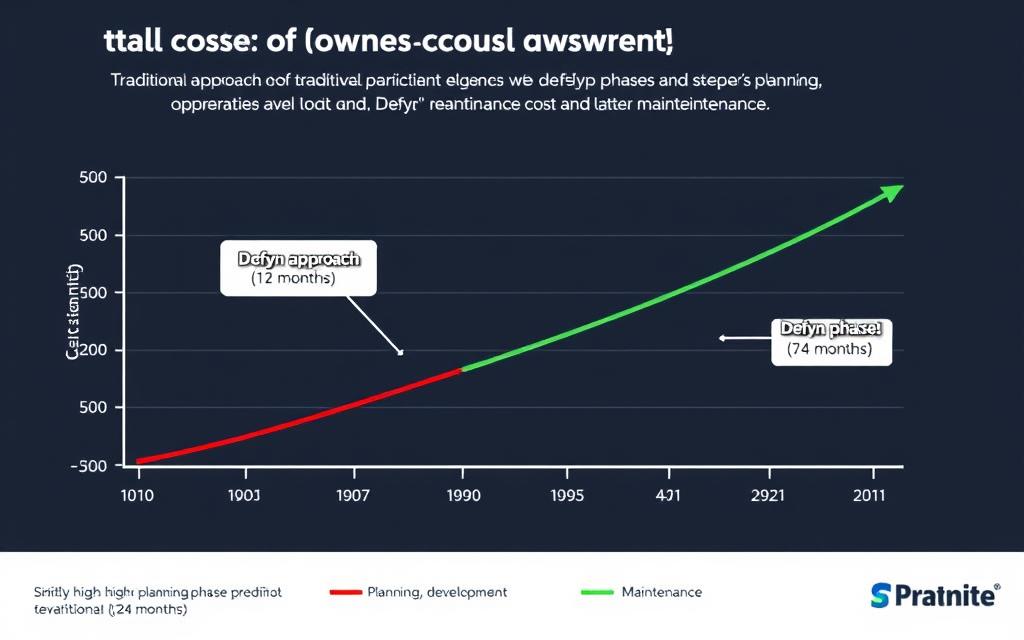
Total cost comparison over a typical 24-month website lifecycle
Case Study: Defyn Approach in Action
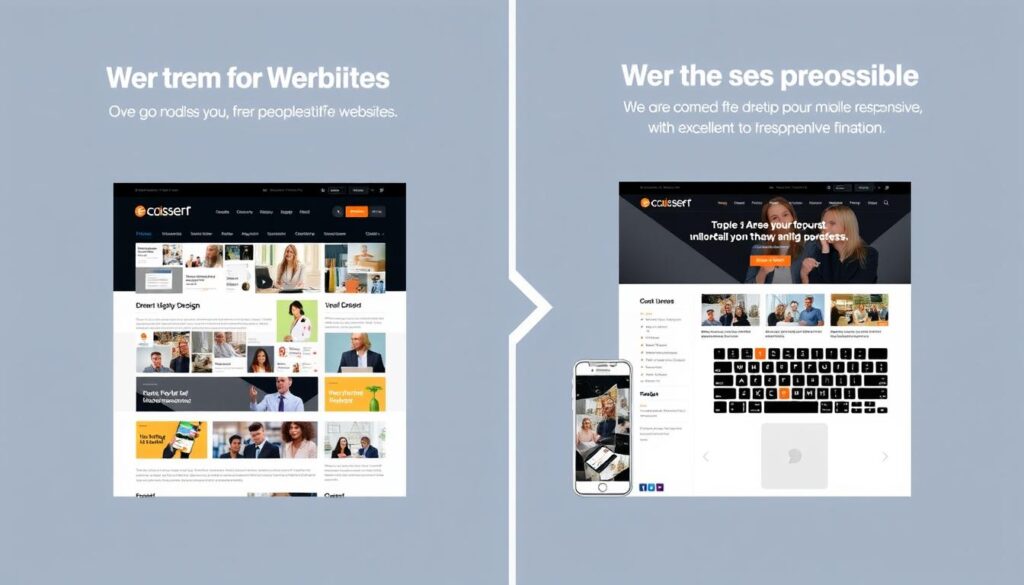
Website transformation for a B2B SaaS client
Client Challenge
A B2B software company approached us after two failed attempts to redesign their website with traditional agencies. Their challenges included:
- Complex product offerings that were difficult to explain visually
- Integration requirements with their customer portal
- Need for regular content updates by non-technical staff
- Tight timeline to coincide with major product launch
The Defyn Solution
We applied our integrated approach to solve these challenges:
- Discovery: Joint workshops with stakeholders, customers, and our combined design-development team
- Strategy: Developed information architecture and technical specifications simultaneously
- Design-Development: Created functional prototypes of key sections while finalizing designs for others
- Implementation: Phased rollout of sections, allowing for content population while development continued
- Training: Hands-on CMS training throughout the process, not just at the end
Results
Timeline
Launched in 8 weeks vs. estimated 14+ weeks with traditional approach
Performance
98/100 Google PageSpeed score, up from 62/100 on previous site
Conversion
43% increase in demo requests within first month after launch
“After two frustrating experiences with traditional agencies, working with Defyn was refreshing. Their integrated approach meant we could see progress early and make adjustments before it was too late or too expensive. The result speaks for itself—a website that truly represents our brand and converts visitors into leads.”
Want to see more examples of our approach?
Explore our portfolio to see how we’ve helped businesses like yours achieve their digital goals.
How We Implement the Defyn Approach
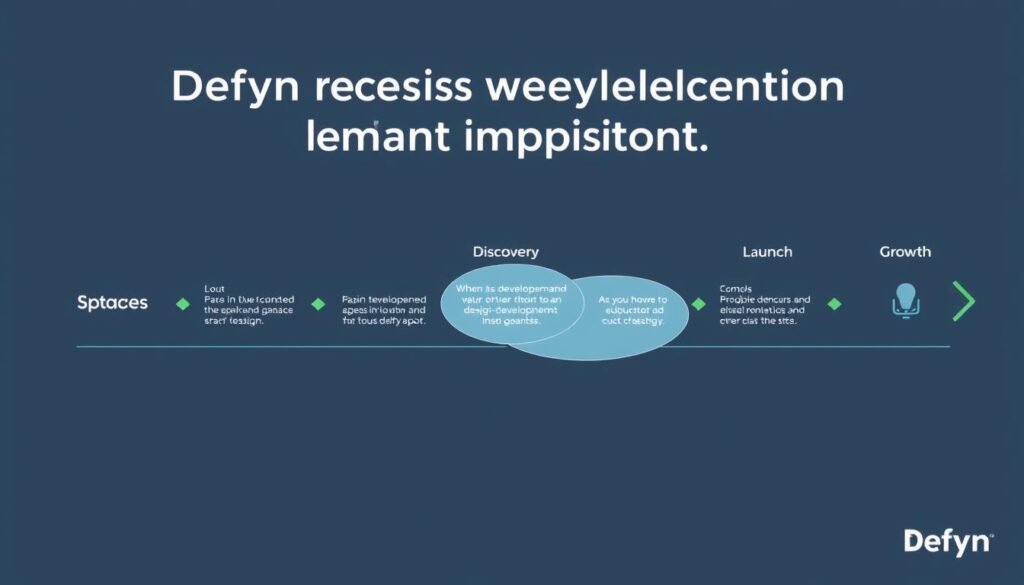
Our implementation process follows five key phases, each designed to maximize efficiency while maintaining quality. Unlike traditional approaches where phases are strictly sequential, our phases often overlap to accelerate delivery.
1. Discovery and Strategy

We begin with a comprehensive discovery process that involves both designers and developers:
- Business goals analysis and alignment
- User research and persona development
- Technical requirements and constraints mapping
- Content strategy and information architecture
- Performance metrics definition
The outcome is a unified strategy document that guides both design and development decisions throughout the project.
2. Integrated Design-Development
Rather than completing all design before beginning development, we work in parallel tracks with continuous collaboration:
Design Track
- Information architecture
- Wireframing key user flows
- Visual design system creation
- Responsive design considerations
- Animation and interaction design
Development Track
- Technical architecture setup
- Component library development
- API and integration planning
- Performance optimization strategy
- Security implementation
3. Iterative Prototyping
We create functional prototypes early in the process to validate assumptions and gather feedback:
- Low-fidelity wireframes for navigation testing
- Visual design prototypes for brand alignment
- Functional prototypes of key features
- Performance testing with real content
4. Phased Implementation
Rather than an all-at-once launch, we often implement in phases:
- Core pages and functionality first
- Secondary features in subsequent releases
- Content migration and optimization
- Integration with marketing and analytics tools
5. Continuous Improvement
Our relationship doesn’t end at launch. We establish a growth-focused partnership:
- Regular performance reviews and optimizations
- User behavior analysis and UX refinements
- Feature prioritization based on data
- Technology updates and security maintenance
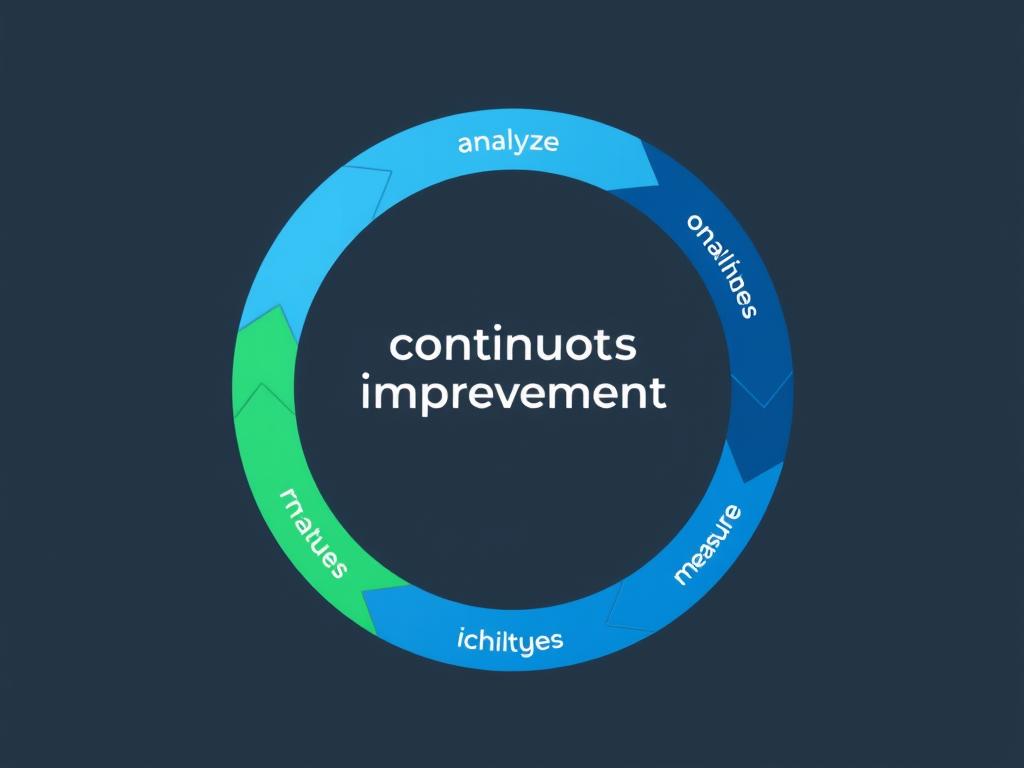
Our continuous improvement cycle ensures your website evolves with your business
The Client Experience with Defyn
Working with Defyn means experiencing a different kind of client relationship. We’ve designed our process to be transparent, educational, and collaborative without requiring excessive time commitment from your team.
What to Expect When Working With Us
Communication
Dedicated project manager as your single point of contact
Weekly progress updates via your preferred channel
24-hour response time to all inquiries
Collaboration
Shared project portal for real-time updates
Structured feedback sessions at key milestones
Clear decision-making frameworks
Transparency
Detailed timeline with dependencies highlighted
Regular budget updates and forecasts
No surprises policy for changes or challenges
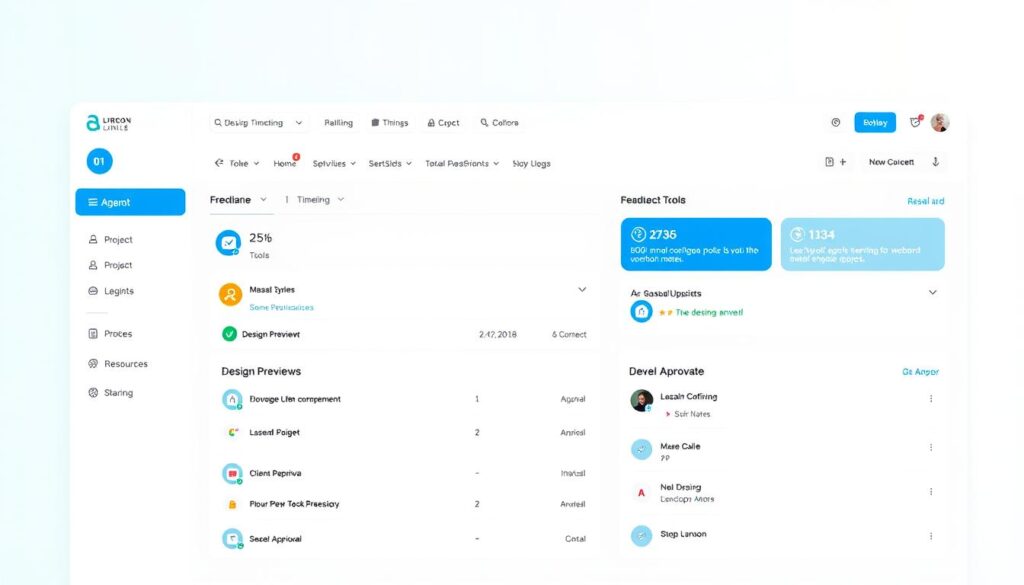
Our client portal provides real-time visibility into your project’s progress
Client Testimonials
“The integrated approach meant we could see how design decisions would impact functionality early on. This saved us from making choices that would have been costly to change later.”
“What impressed me most was how the Defyn team educated us throughout the process. We didn’t just get a great website—we gained valuable insights into digital best practices.”
Ready to experience a better way to build your website?
Let’s discuss your project and how our approach can deliver superior results.
Frequently Asked Questions About Our Approach
How does your approach affect project timelines?
Our integrated approach typically reduces overall project timelines by 30-50% compared to traditional methods. By working on design and development in parallel and catching potential issues early, we eliminate the lengthy revision cycles that often delay traditional projects. Most mid-sized websites can be completed in 8-12 weeks from kickoff to launch.
Is your approach more expensive than traditional methods?
While our initial project costs are comparable to traditional agencies, clients typically see significant savings in the total cost of ownership. This comes from fewer change orders, reduced rework, and lower long-term maintenance costs. Our transparent pricing model ensures you understand exactly what you’re investing in at each stage.
How much time will our team need to commit to the project?
We’ve designed our process to be efficient with your time while still ensuring you have input on critical decisions. Typically, clients commit to a 2-hour kickoff workshop, 30-minute weekly check-ins, and 1-hour review sessions at key milestones. Our client portal also allows for asynchronous feedback that fits into your schedule.
What if we need to make changes during the project?
Our approach is designed to accommodate changes more efficiently than traditional methods. Minor adjustments can often be incorporated without timeline or budget impact. For larger scope changes, we provide clear information about the implications so you can make informed decisions. Our goal is to eliminate surprises while maintaining flexibility.
How do you handle website maintenance after launch?
We offer flexible maintenance plans tailored to your needs. All clients receive a 30-day warranty period after launch for any issues. Beyond that, our growth-focused maintenance plans include regular updates, security monitoring, performance optimization, and strategic improvements based on user data and business goals.
Why Choose Defyn’s Web Design and Development Approach
The digital landscape continues to evolve at a rapid pace, and traditional web development methodologies often struggle to keep up. Defyn’s integrated approach offers a better way forward—one that delivers superior results while respecting your time and budget.

By choosing Defyn, you’re not just getting a website—you’re partnering with a team that’s committed to your digital success. Our approach combines the best of design thinking and technical excellence to create websites that not only look stunning but also perform exceptionally well.
Whether you’re launching a new website, redesigning an existing one, or looking to improve your digital presence, our integrated methodology provides the framework for success. We invite you to experience the Defyn difference for yourself.
Ready to transform your web presence?
Contact us today to discuss your project and discover how our approach can help you achieve your digital goals.
